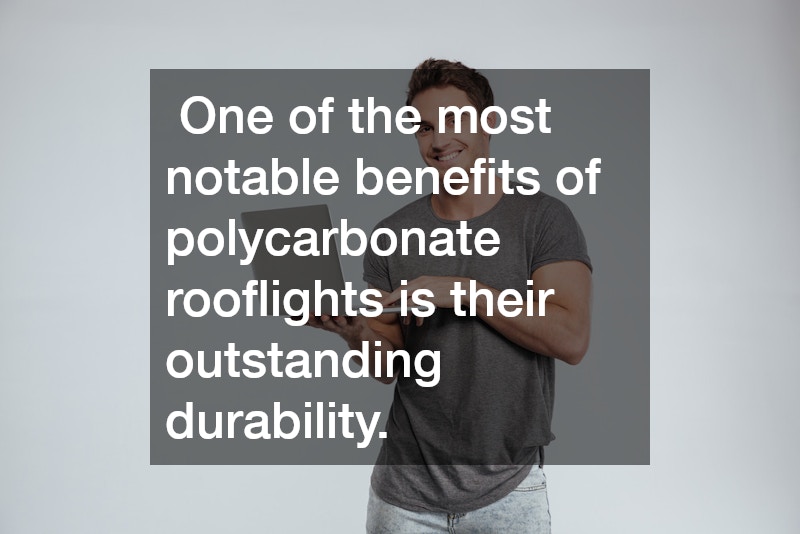In recent years, polycarbonate rooflights have become increasingly popular in both residential and commercial architecture. Their versatility and functionality make them an attractive choice for homeowners and builders alike. This article will delve into the top benefits of using polycarbonate rooflights, highlighting their unique features and advantages.
Durability and Strength
One of the most notable benefits of polycarbonate rooflights is their outstanding durability. Polycarbonate is a high-performance polymer known for its high impact resistance, being up to 250 times stronger than glass. This resilience makes polycarbonate rooflights an exceptional choice for areas prone to harsh weather conditions, such as hailstorms or heavy snowfall.
The strength of polycarbonate rooflights doesn’t only offer protection against weather; it also ensures a long lifespan. With proper maintenance, these rooflights can last several decades without compromising on quality or performance. This longevity makes polycarbonate rooflights a cost-effective investment, providing value over time.
In addition to strength and longevity, polycarbonate is also lightweight, which simplifies installation and reduces structural support requirements. This property lowers the overall cost of installation and maintenance while preserving structural integrity. The lightweight nature of polycarbonate rooflights makes them an ideal option for modern building designs that emphasize minimalistic and clean aesthetics.
Energy Efficiency and Natural Lighting
Polycarbonate rooflights are praised for their excellent thermal insulation properties, contributing significantly to energy efficiency. By allowing natural light to penetrate deep into a building, they reduce the need for artificial lighting during daylight hours. This not only cuts down on electricity bills but also lessens the environmental footprint of buildings equipped with these rooflights.
The design of polycarbonate rooflights supports optimal light diffusion, creating a bright yet pleasantly warm ambiance. Unlike glass, they don’t produce glare, enhancing the comfort of occupants in residential settings or workers in commercial spaces. This balance between light transmittance and thermal insulation is a hallmark of a quality environment that enhances productivity and well-being.
Another key energy-related benefit of polycarbonate rooflights is their ability to block harmful UV rays while allowing natural light to enter. This feature protects interiors from fading and deterioration, helping preserve the aesthetic and functional longevity of furnishings. Furthermore, by blocking UV radiation, these rooflights contribute to a healthier indoor climate, shielding occupants from potential UV-related harm.
Versatility and Design Flexibility
The design potential of polycarbonate rooflights is nearly limitless, given their versatility in shape, size, and color. Architects and designers often choose polycarbonate because it can be easily molded to fit a wide range of design specifications. Whether it’s a subtle addition to a residential structure or a bold architectural statement in a commercial project, polycarbonate can be adapted to meet diverse needs.
This level of adaptability is complemented by various aesthetic options available in polycarbonate rooflights. They come in clear, tinted, or even frosted finishes, providing ample opportunities to enhance or blend with the existing décor. The ability for customization makes polycarbonate rooflights a sought-after solution for those seeking a unique blend of style and function.
Furthermore, the flexibility of polycarbonate rooflights extends beyond aesthetic considerations to functional roles. They can be used in varying types of installations, including flat, pitched, or curved roof structures. This adaptability to different building configurations ensures their utility in both contemporary and traditional architectural styles.
Environmental Benefits
Polycarbonate rooflights present significant environmental advantages, aligning with the global push towards sustainable building practices. The material is recyclable and can be repurposed at the end of its life cycle, minimizing environmental impact. By choosing polycarbonate, users contribute to reducing landfill waste and conserving natural resources.
The aforementioned energy efficiency also ties into the environmental benefits, as reduced energy consumption leads to fewer fossil fuels being burned for electricity. Engaging less with non-renewable resources supports efforts toward greener construction and living practices. In addition, promoting natural lighting helps decrease the collective carbon footprint of a building’s operational lifetime.
In terms of raw material sourcing and production, the manufacture of polycarbonate involves low emissions, supporting a cleaner manufacturing process. The reduced weight of polycarbonate over traditional glass also lowers transportation emissions, as less energy is required to move and handle products. These accumulative benefits signify a step forward in ecologically responsible building solutions.
Conclusion
Polycarbonate rooflights offer a myriad of benefits that make them an ideal choice for modern buildings. Their durability, energy efficiency, sophistication in design, and environmental benefits place them at the forefront of construction materials. By integrating these rooflights, both residential and commercial buildings can achieve enhanced functionality, beauty, and sustainability.
.


